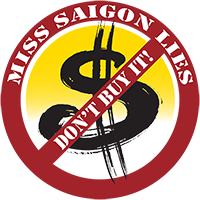by MARIANNE COMBS via MPR
September 9, 2013
When Mu Performing Arts convenes a discussion tonight about Ordway’s production of Miss Saigon, the focus will undoubtedly be on how Asian women continue to be portrayed in American and European musical theater as deferential objects of desire.
That narrative of an “exotic” Asian woman who is beautiful, submissive, and conveniently self-sacrificing is a repeated pattern in theater, notes Josephine Lee, a professor of English and Asian American studies at the University of Minnesota Twin Cities. It’s also one that persists, even in modern society.
“I tell my students sometimes if you want to see where race in our post civil-rights society has gone, you should look at the personal ads,” Lee said. “There are all these ads in City Pages for Asian massage – all of which feature a young beautiful Asian woman who looks like she’s ready to give services. This is the kind of iconography that’s often used to sexualize and exploit the image of Asian women. It’s been with us a very long time – it’s just been modernized.”
The recent debate over the production “Miss Saigon” is nothing new, said Lee, who has a special interest in American and European theater that depicts Asia and Asians. Lee has studied – and taught – the genealogy of Miss Saigon, which dates back to the 19th Century.
“‘Miss Saigon’ is one in a long line of stories of this type,” Lee explained. “Musical theater and opera are full of them. These images are just so familiar.
“It’s not like Miss Saigon is the only work that does this,” she said. “But I think Miss Saigon came out at a time when Asian American actors and media activists were beginning to look for examples of these kinds of representations. And Miss Saigon was seen as yet another in a long list of ‘Madame Butterfly’ stories. Because it was new, and reworked – but not really revised – it came under fire.”
Many musical theater fans know Miss Saigon is a modernized retelling of Puccini’s opera Madame Butterfly. One thing many theater buffs might not be aware of is that both the opera and the musical can be traced to “Madame Chrysanthemum,” a semi-autobiographical 1887 novel by French author Pierre Loti. The novel inspired a short story by John Luther Long called “Madame Butterfly.” Long’s story was the foundation for a one-act play by David Belasco, which Puccini saw in London in the summer of 1900. Thus the opera was born.
Lee finds it interesting to note that early versions of the story featured an Asian woman who was much more independent, and who disappeared with her child, rather than kill herself and give her child up to the father and his new wife.
But the familiar narrative prevailed.
Lee said one reason one reason why the Madame Butterfly story was so popular was because it featured a hyper-feminine Asian woman who is there for the white man in a way that the “modern woman” – the more liberated, intellectual, educated white woman – is not.
Thee problem with the narrative, Lee said, is that it dominates all other depictions of Asian women, and perpetuates racist stereotypes.
“It’s also a story that’s given to us in a way that kind of cuts us off from thinking about it too much, because it’s so romantic and melodramatic and full of music,” she said. “Most of us go to the theater for entertainment – we don’t really want to sit there and analyze it – and we’re fed something that has a very conventional and familiar plot line and so we simply accept that.”
Lee encourages people who choose to see Miss Saigon this fall at the Ordway to take the opportunity to ask themselves some questions. Namely, why is this story so popular? Why does it keep coming up again and again in different forms?
Meanwhile, a cast member of the touring production of “Miss Saigon,” Orville Mendoza, is stepping up to defend the production against allegations that it’s a racist play.
MPR State of the Arts. Marianne Combs has been reporting on the arts in Minnesota since 2000; she first joined MPR in 1993.
